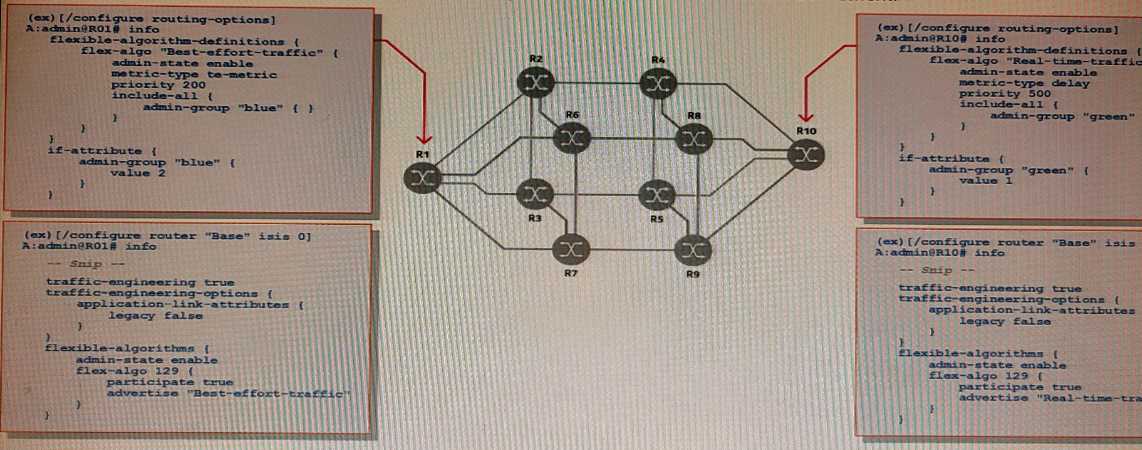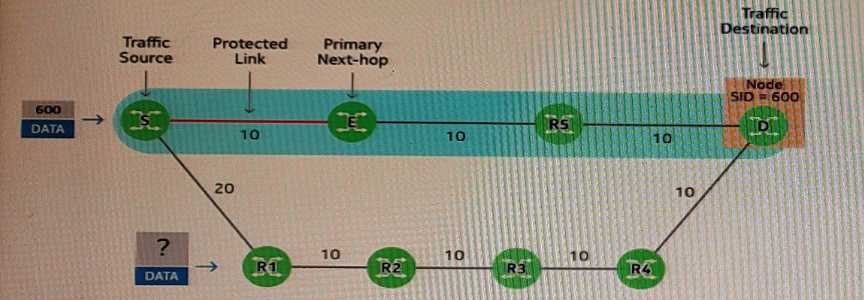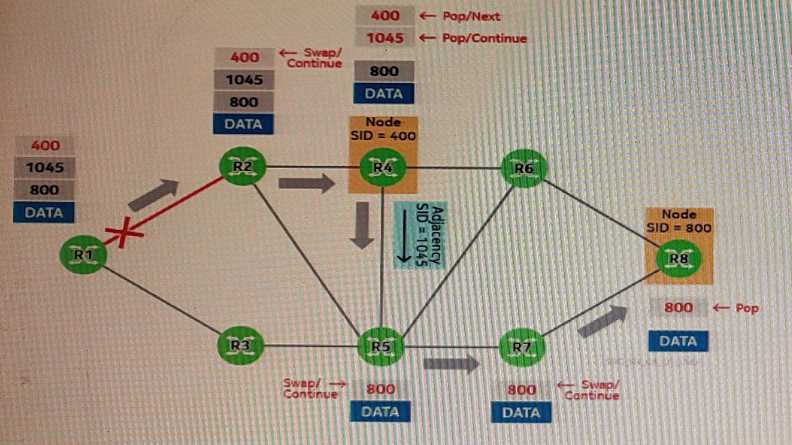nokia 4A0-116 Exam Questions
Questions for the 4A0-116 were updated on : Nov 21 ,2025
Page 1 out of 3. Viewing questions 1-15 out of 40
Question 1
Which of the following is NOT a valid option to steer traffic into a flex-algo segment-routing tunnel?
- A. Using a flex-algo Node-SID as an explicit hop in the path definition of an SR-TE LSP and enabling the sr-te tunnel type for a VPN service.
- B. Specifying the flex-algo instance ID as an additional TE constraint for an SR-TE LSP and enabling the sr-te tunnel type for a VPN service.
- C. Configuring and applying a VRF import policy to a VPRN service and enabling the sr-is-is or sr-ospf tunnel type for the service, depending on the underlying routing protocol.
- D. Configuring and applying a VSI import policy to an EVPN service and enabling the sr-is-is or sr-ospf tunnel type for the service, depending on the underlying routing protocol.
Answer:
D
Explanation:
Applying a VSI import policy to an EVPN service and enabling the sr-is-is or sr-ospf tunnel type for
the service is not a valid option for steering traffic into a flex-algo segment-routing tunnel, VSI is not
related to flex-algo SR.
Question 2
Based on the exhibit, which of the following statements about fast re-route for flex-algo instance 129
is TRUE?
- A. Only standard LFA is enabled on router R1; fast re-route is not enabled on router R2.
- B. Only standard LFA is enabled on both routers R1 and R2.
- C. Standard LFA and remote-LFA are enabled on router R1; fast re-route is not enabled on router R2.
- D. Standard LFA and remote-LFA are enabled on router R1; standard LFA and TT-LFA are enabled on router R2.
Answer:
C
Question 3
Based on the exhibit, and given that the system IP address of router RIO is 10.10.10.10, which of the
following statements is FALSE?
- A. Router Rl participates in at least two flex-algo instances.
- B. Router RIO participates in flex-algo instance 130.
- C. The Node-SID assigned to router RIO for flex-algo instance 129 is 524338.
- D. The underlying routing protocol being used in the network for segment routing is IS-IS.
Answer:
C
Question 4
To create a flex-algo instance in a network, which of the following configuration steps is mandatory?
- A. Configuring the proper values for the shared-risk link groups (SRLGs) that will define the flex-algo topology.
- B. Configuring at least one router in the network to create and advertise the flex-algo definition.
- C. Specifying whether the LSP paths will be computed locally or by an external path computation element (PCE).
- D. Configuring LSPs between every pair of PE routers.
Answer:
B
Explanation:
To create a flex-algo instance in a network, it's mandatory to configure at least one router in the
network to create and advertise the flex-algo definition, This is the first step in creating a flex-algo
instance, and it's done by defining the flex-algo instance and its properties on one or more routers in
the network.
The other steps are important to fine-tune the flex-algo instance, but not mandatory to create it.
Configuring the proper values for the shared-risk link groups (SRLGs) that will define the flex-algo
topology.
Specifying whether the LSP paths will be computed locally or by an external path computation
element (PCE).
Configuring LSPs between every pair of PE routers.
Question 5
Based on the configuration shown for routers R1 and R10, what valid flex-algo definitions exist in the
network?
- A. No valid flex-algo definitions, because of the conflicting parameters.
- B. One valid flex-algo definition, using delay as the link metric and including green links.
- C. One valid flex-algo definition, using te-metric as the link metric and including blue links.
- D. Two valid flex-algo definitions, one uses te-metric as the link metric and includes blue links and the other uses delay as the link met includes green links.
Answer:
D
Question 6
In which of the following aspects does the configuration of flex-algo LSPs have an advantage over the
configuration of SR-TE LSPs?
- A. Label stack size of the encapsulated data packets
- B. List of traffic-engineering constraint types available to choose from
- C. Ability to associate one primary and up to two secondary paths to the same LSP
- D. Flexibility of configuring each LSP with its own set of traffic-engineering constraints
Answer:
D
Explanation:
Flex-Algo LSPs are a type of LSP that allows for greater flexibility in configuring traffic engineering
constraints. This is because flex-algo LSPs can be configured with a unique set of traffic engineering
constraints for each LSP, whereas SR-TE LSPs use a predefined set of traffic engineering constraints
that applies to all LSPs.
Label stack size of the encapsulated data packets, List of traffic-engineering constraint types available
to choose from, and Ability to associate one primary and up to two secondary paths to the same LSP
are not the advantages of flex-algo LSPs over SR-TE LSPs.
Question 7
The exhibit shows the fast re-route configuration on router R1, in which both R-LFA and TI-LFA have
been enabled. Assume that there are multiple potential backup paths for a given prefix. Which of the
following options will router R1 use?
- A. A standard LFA path that would not coincide with the path after IGP re-convergence.
- B. An R-LFA path that would not coincide with the path after IGP re-convergence.
- C. A D-LFA path that would not coincide with the path after IGP re-convergence.
- D. A D-LFA path that would coincide with the path after IGP re-convergence.
Answer:
D
Explanation:
The exhibit shows that both R-LFA and TI-LFA have been enabled on router R1. R-LFA (Remote Loop-
Free Alternate) is a method that is used to protect the active segment of a tunnel, and it allows the
router to find a backup path that coincides with the path that will become active after IGP
reconvergence. TI-LFA (Topology Independent LFA) is a method that is used to protect an end-to-end
multi-segment tunnel, it allows the router to find a backup path that does not rely on the IGP
topology, but on the segment routing topology.
With R-LFA and TI-LFA enabled, router R1 will use a D-LFA (Dual-Loop-Free Alternate) path, which is a
combination of both R-LFA and TI-LFA, this path will coincide with the path after IGP re-convergence.
A standard LFA, R-LFA, and D-LFA which do not coincide with the path after IGP re-convergence are
not the options.
Question 8
For any of the LFA methods to work properly, there must be a router in the backup path that will
forward traffic addressed to the destination without sending it back to the source. Which of the
following statements describes the way R-LFA selects such a router?
- A. It selects an immediate neighbor.
- B. It selects a remote router, reachable through a tunnel defined by a single Node-SID.
- C. It selects a remote router, reachable through a tunnel defined by a Node-SID and one or two Adjacency-SIDs.
- D. It can select an immediate neighbor or a remote router, as long as the backup path coincides with the path that will become active after IGP reconvergence.
Answer:
D
Explanation:
R-LFA (Remote Loop-Free Alternate) is a method that can select either an immediate neighbor or a
remote router to be used as a backup next hop, as long as the backup path coincides with the path
that will become active after IGP reconvergence.
Question 9
Loopfree-alternate has been enabled on a router for its link-state routing protocol. For which types of
segments will the router attempt to find a backup path, so that they become protected by fast re-
route?
- A. Only segments defined by a Node-SID.
- B. Only segments defined by an Adjacency-SID.
- C. Segments defined by a Node-SID and segments defined by an Adjacency-SID.
- D. No segments, unless segment-routing fast-reroute is also explicitly enabled.
Answer:
C
Explanation:
Loopfree-alternate is a mechanism that enables fast re-route for link-state routing protocols, it allows
the router to find a backup path for both Node-SID and Adjacency-SID segments, so that they
become protected by fast re-route.
Question 10
The exhibit highlights in blue the primary path of a segment going from router S to router D. The
exhibit also shows a backup path. The protected link fails and fast re-route is triggered on router S. If
the backup path has been calculated using standard LFA, how many SIDs are included in the label
stack of the data packet forwarded to router R1?
- A. 1
- B. 2
- C. 3
- D. 4
Answer:
A
Question 11
The exhibit presents packets being transmitted inside an LSP's multi-segment primary path going
from router R1 to router R8. The LSP also has a standby secondary path, and Seamless-BFD has been
enabled on the primary path. The link between routers R1 and R2 fails, and fast re-route (FRR) is
triggered. As a result, router R1 forwards the packets to router R3 and adds the proper FRR
encapsulation to reach which router?
- A. To reach router R2, which is the LSP's intended next-hop.
- B. To reach router R5, which is the shortest way to go back to the original path.
- C. To reach router R4, which is the tail-end of the active segment.
- D. To reach router R8, which is the tail-end of the LSP.
Answer:
B
Question 12
Which of the following statements about segment routing fast re-route is FALSE?
- A. Fast re-route is a temporary fix that becomes active for a short period of time after a local network failure.
- B. Fast re-route typically protects the active segment of a tunnel, but under certain conditions it can protect an end-to-end multi-segment tunnel instead.
- C. On a Nokia 7750 SR, R-LFA and TI-LFA can be enabled independently of each other.
- D. The parameter "max-sr-frr-labels" limits the number of labels that R-LFA can add to the data packet encapsulation.
Answer:
C
Explanation:
On a Nokia 7750 SR, R-LFA and TI-LFA cannot be enabled independently; they must be enabled
together. The parameter "max-sr-frr-labels" limits the number of labels that R-LFA can add to the
data packet encapsulation.
Question 13
In the context of a network that includes a Path Computation Element (PCE), what is a PCC-initiated
LSP?
- A. An LSP that needs to be explicitly configured on the head-end router.
- B. An LSP for which the initial path is calculated by the head-end router.
- C. An LSP for which the path repairs and re-optimizations must be triggered by the head-end router.
- D. An LSP whose existence and state are reported to the PCE.
Answer:
D
Explanation:
A PCC-initiated LSP is an LSP that is established and controlled by the PCC (Path Computation Client)
which is typically a head-end router. The PCC sends LSP setup and teardown requests to the PCE and
also reports the existence and state of the LSPs to the PCE. The PCE then uses this information to
perform path computation and to monitor the state of the LSPs.
Question 14
Which of the following is NOT an advantage of using a PCE for the computation of TE-constrained LSP
paths, as compared to using CSPF locally on the PE router?
- A. The ability to create cross-area TE-constrained LSP paths
- B. The ability to create LSP paths with bandwidth reservation
- C. The ability to create LSPs with primary and secondary paths
- D. The ability to ensure that some LSP paths are disjoint
Answer:
B
Explanation:
PCE does not have the capability to reserve bandwidth, This is a function of a Resource Reservation
Protocol (RSVP) or a Label Distribution Protocol (LDP) and is done locally on the PE.
PCE can have advantages such as:
The ability to create cross-area TE-constrained LSP paths
The ability to create LSPs with primary and secondary paths
The ability to ensure that some LSP paths are disjoint
it can be used to optimize the path computation by centralizing the path calculation and by taking
into account a global view of the network.
Question 15
Which of the following types of information is considered by a stateless PCE when it processes a new
LSP path calculation request?
- A. The IGP link-state database
- B. The traffic-engineering database
- C. The operational state of existing LSP paths
- D. The amount of bandwidth reserved for each of the existing LSP paths
Answer:
A